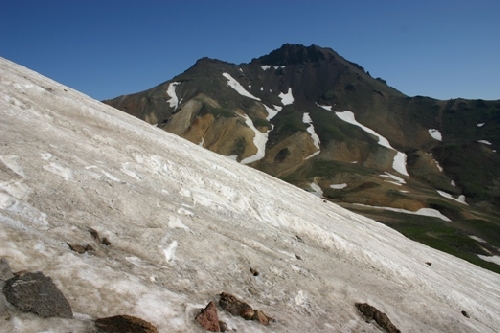|
Duration 7 hours
Mount Aragats ("Արագած" in Armenian) is the highest point
in Armenia, northwest from Yerevan. It is a standalone
extinct stratovolcano with four main peaks forming the rim
of the crater, and is a popular destination for local
alpinists. Located on its slopes are the Byurakan
Observatory and the medieval Amberd Fortress. Mount
Aragats is a popular destination for tourists,
especially in summer.
and the medieval Amberd Fortress. Mount
Aragats is a popular destination for tourists,
especially in summer.
The 4095-m-high main edifice of Aragats is dissected by
glaciers and is of Pliocene-to-Pleistocene age. Satellitic
cones and fissures are located on all sides of
the volcano and were the source
of large lava flows that
descended its lower flanks.
Several of these were considered to be of
Holocene age, but later Potassium-Argon dating indicated
mid- to late-Pleistocene ages.
 The
youngest lower-flank flows have not been precisely dated,
but are constrained as occurring between the end of the
late-Pleistocene and 3000 BC. The
youngest lower-flank flows have not been precisely dated,
but are constrained as occurring between the end of the
late-Pleistocene and 3000 BC.




Amberd Fortress and Church
Amberd translates to fortress in the clouds in Armenian.
It is located 2,300 meters above sea level on the slopes
of the Mount Aragats. The fortress was founded in the 7th
century as a possession of the noble House of Kamsarakan
dynasty. Four centuries later, it was purchased by the
Pahlavuni noble family and rebuilt by Vahram Pahlavuni.
Vahram fortified the complex with thicker stone walls and
added
 three
bastions along the ridge of the
Arkhashyan canyon. The domed church was built in 1026 as
testified by the inscriptions made on it; it's located
between the castle and the edge of hill, looking down on
the Arkhashyan river. A bath-house built in the same
period and quite unusual for a military installation has
also remained moderately intact along with the water
supply system. three
bastions along the ridge of the
Arkhashyan canyon. The domed church was built in 1026 as
testified by the inscriptions made on it; it's located
between the castle and the edge of hill, looking down on
the Arkhashyan river. A bath-house built in the same
period and quite unusual for a military installation has
also remained moderately intact along with the water
supply system.



|


